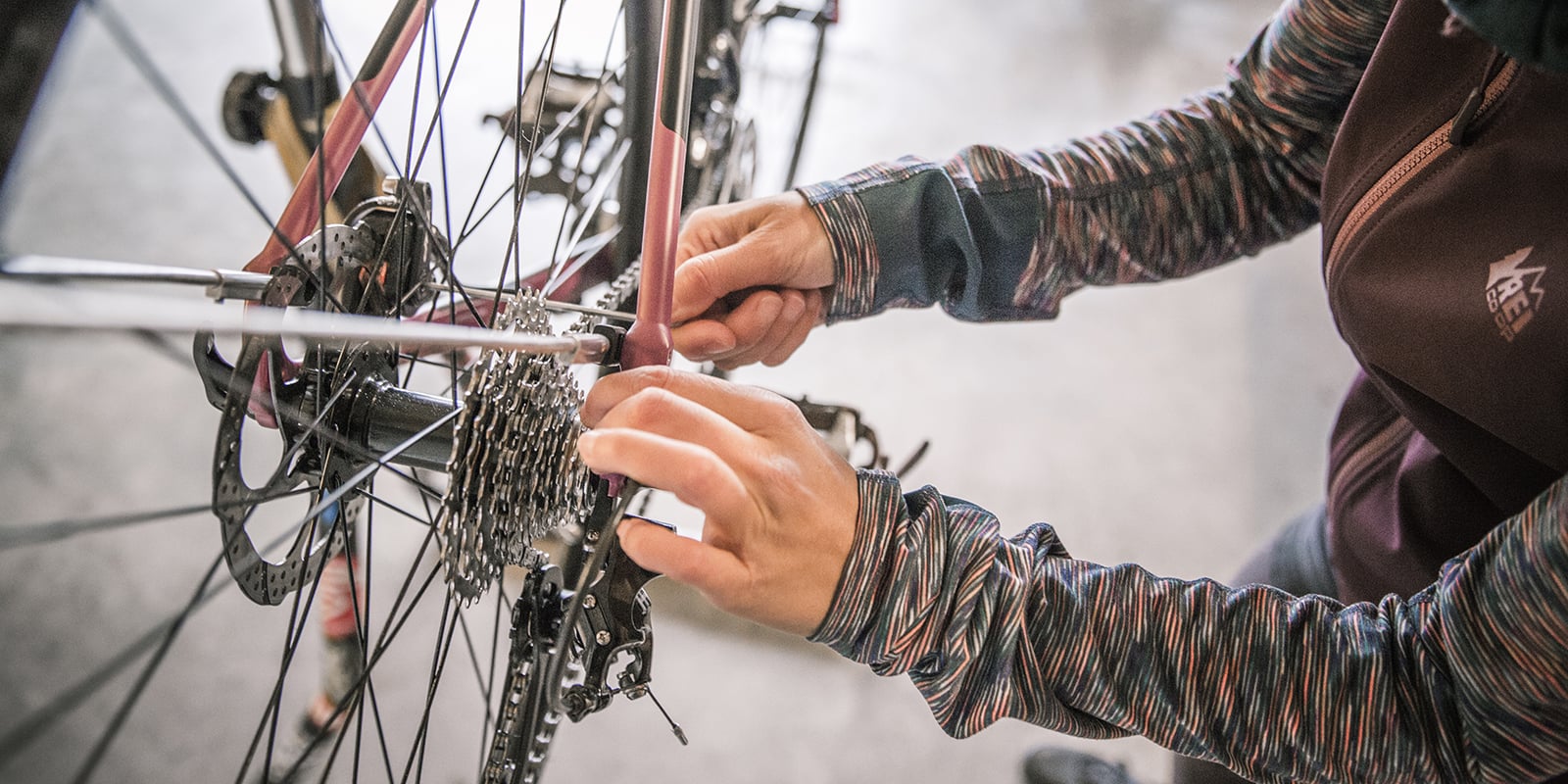To properly maintain a mountain bike, regularly clean it, check and adjust the tire pressure, lubricate the chain, and inspect the brake pads for wear. Maintaining your mountain bike in top condition not only ensures a smooth and safe ride, but it also extends the lifespan of your equipment.
Whether you are a novice rider or a seasoned pro, taking the time to properly care for your bike will pay off in the long run. By following a few simple maintenance routines, you can prevent costly repairs and enjoy optimal performance on your adventures off-road.
We will provide you with essential tips and techniques on how to effectively maintain your mountain bike. From cleaning and tire pressure checks to chain lubrication and brake pad inspection, we have got you covered. So, let’s dive in and discover the best practices to keep your mountain bike in fantastic shape.
Choosing The Right Mountain Bike
Choosing the right mountain bike is crucial to ensure an enjoyable and safe riding experience. With so many options available in the market, it can be overwhelming to make a decision. By considering your riding style and evaluating different bike types, you can find the perfect mountain bike that suits your needs. Let’s dive into these factors and help you make an informed choice.
Consider Your Riding Style
Before purchasing a mountain bike, it’s important to consider your riding style. Are you someone who enjoys tackling steep and technical trails or do you prefer more casual rides on smoother terrains? Understanding your riding style will help you determine the type of mountain bike that suits you best.
Evaluate Different Bike Types
Once you have identified your riding style, it’s time to evaluate different bike types available in the market. Here is a breakdown of the main types of mountain bikes:
- Cross-Country Bikes: These bikes are designed for speed and efficiency. They are lightweight and excel on long climbs and rolling terrains. Perfect for riders who prioritize endurance and covering long distances.
- Trail Bikes: Trail bikes are versatile and suitable for a wide range of riders. They offer a good balance between climbing ability and descending prowess. Trail bikes are ideal for riders who enjoy a mix of uphill and downhill riding.
- All-Mountain Bikes: All-mountain bikes are built to handle more aggressive downhill terrain while still providing decent climbing ability. They are perfect for riders who seek versatility and enjoy tackling challenging trails.
- Downhill Bikes: Designed specifically for downhill riding, these bikes excel at high speeds and tackle technical descents. They feature long-travel suspension and robust construction to handle the toughest terrains.
- Fat Bikes: Fat bikes are known for their oversized tires, providing excellent traction on loose surfaces like sand or snow. They are suitable for riders who enjoy exploring off-the-beaten-path and venturing into extreme conditions.
With these different bike types in mind, you can now shortlist the ones that align with your riding style and preferences. Keep in mind that there may be overlap between certain bike categories, and you can always consult with a knowledgeable salesperson or do further research to find the perfect mountain bike for you.

Credit: www.rei.com
Essential Maintenance Tools
When it comes to keeping your mountain bike in top condition, having the right tools is essential. Below, we discuss the must-have tools and supplies for maintaining your bike efficiently.
Basic Tool Kit
A basic tool kit consisting of Allen keys, screwdrivers, a chain breaker, and tire levers is crucial for handling minor repairs and adjustments on your mountain bike.
Specialized Cleaning Supplies
Investing in specialized cleaning supplies such as bike-specific degreasers, brushes, and chain lubes ensures effective maintenance and prolongs the lifespan of your bike.
Regular Cleaning Practices
Properly maintaining a mountain bike includes regular cleaning practices to ensure optimal performance and longevity. Cleaning the bike after each ride with water and gentle soap, lubricating the chain, and inspecting for any damages are essential steps. Regular check-ups and maintenance will keep the mountain bike in top condition for a smooth and enjoyable ride.
Pre-ride Check
Before embarking on your mountain biking adventure, it’s important to perform a thorough pre-ride check to ensure your bike is in optimal condition. This will not only enhance your riding experience but also promote the longevity of your bike’s components. Start by visually inspecting the frame, forks, and suspension for any signs of damage or wear. Check that all bolts are tight and secure, including those on the stem, handlebars, and saddle. Make sure your tires are properly inflated and free of any cuts or punctures. Give the chain a quick once-over to ensure it is clean and lubricated. Finally, test the brakes to ensure they are responsive and functioning properly.
Post-ride Cleaning Routine
After a thrilling ride on the trails, it’s crucial to give your mountain bike some TLC to keep it performing at its best. A regular post-ride cleaning routine will not only help prevent component deterioration but also keep your bike looking fresh and well-maintained. Begin by rinsing your bike with a hose or bucket of water to remove any loose dirt, mud, or debris. Use a soft brush or sponge and a mild detergent to scrub away stubborn dirt and grime from the frame, wheels, and drivetrain.
Pay extra attention to hard-to-reach areas such as the cassette and chainrings. Once you’ve thoroughly cleaned the bike, rinse off any remaining detergent and dry it using a clean, lint-free cloth. Be sure to dry the chain and other components thoroughly to prevent rust and corrosion. Apply a bicycle-specific lubricant to the chain and derailleurs, wiping off any excess fluid. To prolong the life of your bike’s suspension, consider giving it a quick wipe-down and applying suspension fork oil.
Lastly, inspect the tires for cuts, punctures, or excessive wear. Replace any damaged or worn-out tires for optimal safety on your next ride. Remember, a clean bike not only looks great but also performs better, ensuring a smoother and more enjoyable ride. By incorporating these regular cleaning practices into your maintenance routine, you’ll extend the lifespan of your mountain bike and keep it in peak condition for many adventures to come.

Credit: www.singletracks.com
Inspecting And Lubricating Components
To ensure your mountain bike is in peak condition, regularly inspect and lubricate its components. This will help prevent wear and tear, reducing the need for costly repairs and keeping your bike in top shape for your next outdoor adventure.
Regular maintenance is essential for a smooth and enjoyable ride.
Checking Chain Wear
Regularly inspect the chain for visible signs of wear, such as rust or stretching.
Use a chain wear indicator tool to measure the elongation of the chain accurately.
Lubricating Moving Parts
Apply bicycle-specific lubricant to the chain, derailleurs, and cables to reduce friction.
Make sure to wipe off any excess lubricant to prevent attracting dirt and debris.
Proper Tire And Wheel Maintenance
Proper tire and wheel maintenance is essential for maximizing the performance and longevity of your mountain bike. Regularly maintaining your tires and wheels can prevent accidents and ensure a smooth, safe ride. This section will cover the key aspects of proper tire and wheel maintenance to keep your mountain bike in top condition.
Maintaining Tire Pressure
Maintaining the right tire pressure is crucial for optimal performance and handling. Check your tire pressure regularly using a pressure gauge to ensure it aligns with the manufacturer’s recommendations. Adjust the pressure as needed to match the specific terrain and riding conditions you anticipate. Proper tire pressure not only enhances traction and control but also reduces the risk of flats and rim damage.
Inspecting Spokes And Rim Alignment
Regular inspections of your spokes and rim alignment are essential to ensure the structural integrity of your wheels. Inspect the spoke tension to detect any loose or damaged spokes, and address any issues promptly to prevent wheel misalignment. Check for any wobbling or unevenness in the rim, and adjust as necessary to maintain proper alignment for a stable and balanced ride.

Credit: m.youtube.com
Suspension System Care
Properly maintaining the suspension system of your mountain bike is crucial for ensuring a smooth and comfortable ride. The suspension system plays a vital role in absorbing shocks and impacts encountered during off-road biking, and neglecting its care can lead to decreased performance and potential safety issues. In this section, we will discuss two essential aspects of suspension system care: checking and adjusting suspension sag, and cleaning and lubricating suspension components.
Checking And Adjusting Suspension Sag
Checking and adjusting suspension sag is a critical part of maintaining your mountain bike’s suspension system. Sag refers to the amount of suspension travel compressed when the rider is in a neutral riding position. To check the suspension sag, follow these steps:
- Measure the shock’s total travel length.
- Ensure your bike is in a standing position with no weight on it, then measure the distance from the o-ring on the shock to the shock body.
- Compare this measurement to the shock’s total travel length. Ideally, the sag should be around 25-30% of the total travel length.
Cleaning And Lubricating Suspension Components
Cleaning and lubricating suspension components are essential for maintaining the performance and lifespan of your mountain bike’s suspension system. Dirt, mud, and grime can build up on the suspension components, affecting their functionality. Here are the steps to clean and lubricate your suspension components:
- Wash the suspension components with a mild soap and water solution to remove dirt and grime.
- Inspect the seals and stanchions for any signs of wear or damage.
- Lubricate the seals and stanchions with a specific suspension fork lube, ensuring smooth operation and preventing premature wear.
- Check the manufacturer’s recommendations for specific maintenance intervals and lubrication products.
Brake System Inspection And Adjustment
Ensure optimal performance on your mountain bike by regularly scheduling brake system inspections and adjustments. This maintenance practice is crucial for safe and efficient rides through challenging terrains. Professional attention to your brakes will enhance your overall biking experience.
Checking Brake Pads And Rotors
One crucial element of maintaining your mountain bike’s brake system is regularly checking the condition of the brake pads and rotors. By ensuring that both components are in good shape, you can help prevent accidents and maintain optimal braking performance. To inspect the brake pads, first, remove the wheels by loosening the quick-release levers or unscrewing the thru-axles.”
Next, visually examine the brake pads for wear. If the pad material is less than 3mm thick or has uneven wear, it’s time to replace it for a consistent and reliable stopping power. Also, keep an eye out for any signs of contamination, such as oil or grease, which can reduce the pads’ effectiveness.
To inspect the rotors, examine the braking surface for signs of deep grooves or uneven wear. If you notice any significant damage or warping, it’s best to replace the rotors altogether. In case the rotors appear dirty, you can clean them using isopropyl alcohol or a dedicated brake cleaner. Remember to wipe them dry before reassembling them.
Adjusting Cable Tension Or Bleeding Hydraulic Brakes
Another crucial aspect of maintaining your mountain bike’s brake system is ensuring the proper tension of the brake cables or bleeding hydraulic brakes when necessary. Whether your bike has cable-actuated disc brakes or hydraulic disc brakes, both require periodic adjustments and maintenance.
If your mountain bike has cable-actuated disc brakes, start by checking the cable tension. To do this, squeeze the brake lever and observe how far it moves before engaging the brake pads. If the lever has excessive travel, you need to tighten the cable by turning the adjuster barrel found on the brake caliper or brake lever. However, if the lever feels too hard to pull, you should loosen the cable tension accordingly.
For hydraulic disc brakes, periodically bleeding the system helps maintain consistent braking performance. Brake fluid can become contaminated over time, affecting the effectiveness and responsiveness of your brakes. Bleeding your hydraulic brakes involves removing the old fluid and replacing it with fresh fluid, ensuring any air bubbles are eliminated from the system. Consulting your bicycle’s user manual or seeking professional help is recommended if you’re unfamiliar with the process.
Remember, maintaining a properly functioning brake system is crucial for your safety while mountain biking. Regularly checking brake pads and rotors, as well as adjusting cable tension or bleeding hydraulic brakes, will help ensure reliable and consistent braking performance on the trails.
Protecting And Storing Your Mountain Bike
Maintaining your mountain bike properly is essential to ensure its longevity and performance. One crucial aspect of maintenance is protecting and storing your mountain bike correctly.
Proper Storage Practices
Storing your mountain bike correctly can help prolong its lifespan and prevent damage. Follow these tips for proper storage:
- Avoid leaving your bike outdoors and exposed to the elements.
- Store your bike in a cool, dry place away from direct sunlight.
- Hang your bike vertically using a sturdy wall mount or store it on a bike rack.
Protecting Against Rust And Corrosion
Rust and corrosion can significantly damage your mountain bike if not addressed. Take the following steps to protect your bike against rust and corrosion:
- Regularly clean and dry your bike after rides, especially if you’ve been riding in wet or muddy conditions.
- Apply a protective layer of bike-specific lubricant to metal components to prevent rust.
- Inspect your bike for signs of rust or corrosion regularly and address any issues promptly.
Frequently Asked Questions
What Maintenance Does A Mountain Bike Need?
A mountain bike needs regular maintenance which includes cleaning, lubricating the chain, checking tire pressure, and inspecting the brakes for optimal performance and safety. Keeping your bike well-maintained ensures a smoother ride and extends its lifespan.
Are Mountain Bikes Hard To Maintain?
Maintaining mountain bikes can require regular cleaning, lubrication, and part replacements. Proper maintenance ensures optimal performance and longevity. Regular tune-ups from a professional can also be beneficial.
Is It OK to Hose Down Your Mountain Bike?
Yes, it’s okay to hose down your mountain bike. It helps remove dirt, mud, and debris. But be cautious: avoid spraying directly at bearing points and delicate parts. Instead, use a low-pressure setting and targeted water stream to clean the bike thoroughly.
Remember to dry it properly afterward.
Should You Wash Your Mtb After Every Ride?
Yes, washing your MTB after every ride helps maintain its performance and longevity. Dirt and grime can cause damage, so a quick wash can prevent issues.
Conclusion
Maintaining a mountain bike is essential for optimal performance and longevity. By following the steps outlined in this guide, you can ensure the safety and functionality of your bike while enjoying a smoother ride. Regular cleaning, inspection, lubrication, and adjustment of various components will not only enhance your cycling experience but also extend the lifespan of your mountain bike.
So, equip yourself with the necessary tools and knowledge, and get ready to conquer the trails with a well-maintained bike!



